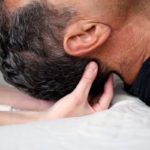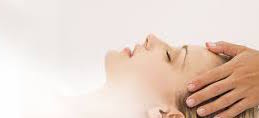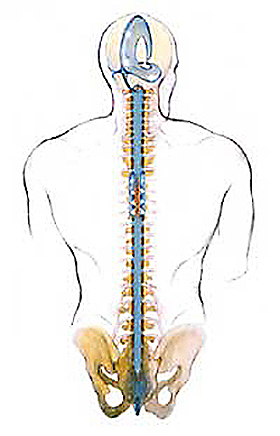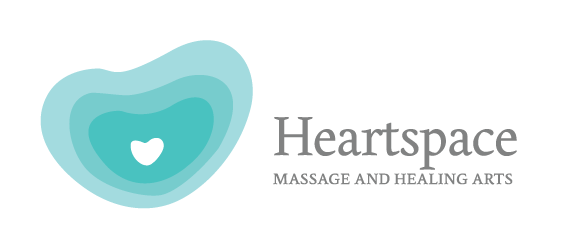Craniosacral Therapy / Somatoemotional Release
My training in Craniosacral Therapy and Somatoemotional Release is through Upledger Institute. I find that it is much more effective in creating change than deeper types of modalities. The wisdom of the body knows how to put itself back into its proper place or unravel whatever that it is needed when there is allowing. I now have even more trust in the idea of “less is more.”
– Constance
What is CranioSacral Therapy?
 CranioSacral Therapy (CST) is a gentle, hands-on approach that releases tensions deep in the body to relieve pain and dysfunction and improve whole-body health and performance. Using a soft touch which is generally no greater than 5 grams (about the weight of a nickel) practitioners release restrictions in the soft tissues that surround the central nervous system. CST is increasingly used as a preventive health measure for its ability to bolster resistance to disease, and it’s effective for a wide range of medical problems associated with pain and dysfunction.
CranioSacral Therapy (CST) is a gentle, hands-on approach that releases tensions deep in the body to relieve pain and dysfunction and improve whole-body health and performance. Using a soft touch which is generally no greater than 5 grams (about the weight of a nickel) practitioners release restrictions in the soft tissues that surround the central nervous system. CST is increasingly used as a preventive health measure for its ability to bolster resistance to disease, and it’s effective for a wide range of medical problems associated with pain and dysfunction.
What is Somatoemotional Release?
S omatoemotional Release is a therapeutic process that contains elements of craniosacral therapy which helps free the mind and body of residual effects of past traumas. If emotion cannot be expressed or released at the time it was generated, or if a trauma is accompanied by strong emotions, the particular emotion(s) may become trapped in the tissues of the body. It becomes something called energy cysts. When these unconscious energy cysts are not released, they can spread strain to other parts of the body. Usually your body will adjust to these strain patterns and will begin to feel normal. However, later on in life, these strain patterns can eventually cause chronic pain of which the cause is unknown. SER is the process of discovering and releasing or redirecting the emotion or emotional energy.
omatoemotional Release is a therapeutic process that contains elements of craniosacral therapy which helps free the mind and body of residual effects of past traumas. If emotion cannot be expressed or released at the time it was generated, or if a trauma is accompanied by strong emotions, the particular emotion(s) may become trapped in the tissues of the body. It becomes something called energy cysts. When these unconscious energy cysts are not released, they can spread strain to other parts of the body. Usually your body will adjust to these strain patterns and will begin to feel normal. However, later on in life, these strain patterns can eventually cause chronic pain of which the cause is unknown. SER is the process of discovering and releasing or redirecting the emotion or emotional energy.
How does CranioSacral Therapy Work?
Few structures have as much influence over the body’s ability to function properly as the brain and spinal cord that make up the central nervous system. And, the central nervous system is heavily influenced by the craniosacral system- Â the membranes and fluid that surround, protect and nourish the brain and spinal cord.
Every day your body endures stresses and strains that it must work to compensate for. Unfortunately, these changes often cause body tissues to tighten and distort the craniosacral system. These distortions can then cause tension to form around the brain and spinal cord resulting in restrictions. This can create a barrier to the healthy performance of the central nervous system, and potentially every other system it interacts with.
Fortunately, such restrictions can be detected and corrected using simple methods of touch. With a light touch, the CST practitioner uses his or her hands to evaluate the craniosacral system by gently feeling various locations of the body to test for the ease of motion and rhythm of the cerebrospinal fluid pulsing around the brain and spinal cord. Soft-touch techniques are then used to release restrictions in any tissues influencing the craniosacral system.
By normalizing the environment around the brain and spinal cord and enhancing the body’s ability to self-correct, CranioSacral Therapy is able to alleviate a wide variety of dysfunctions, from chronic pain and sports injuries to stroke and neurological impairment.
What conditions can be addressed?
- Migraines and Headaches
- Chronic Neck and Back Pain
- Stress and Tension-Related Disorders
- Motor-Coordination Impairments
- Infant and Childhood Disorders
- Brain and Spinal Cord Injuries
- Chronic Fatigue
- Fibromyalgia
- TMJ Syndrome
- Scoliosis
- Central Nervous System Disorders
- Learning Disabilities
- ADD/ADHD
- Post-Traumatic Stress Disorder
- Orthopedic Problems
- emotional issues: anxiety, stress, depression, PTSD, mood swings, nervousness, etc.
- And Many Other Conditions
Is there any condition for which CST shouldn’t be used?
There are certain situations where application of CST would not be recommended. These include conditions where a variation and/or slight increase in intracranial pressure would cause instability. Acute aneurysm, cerebral hemorrhage, recent Head trauma, skull fracture, acute stroke or other preexisting severe bleeding disorders are examples of conditions that could be affected by small intracranial pressure changes.
What would I expect during a session?
You would be receiving by lying face up on a heated (optional) massage table fully clothed. Light touches and supports are positioned at different areas of the body at various intervals of time. Areas may include arms, legs,sacrum torso, neck, head, face, etc. Even inside the mouth in order for further realignment if that feels appropriate.
The intentions of the gentle touches are to detect and listen to the cranio rhythm, to realign tissue and bones, or to direct energy.
In Somatoemotional Release, the therapist may assist the process of releasing and increasing an awareness of your inner self by supporting a limb, offering energy to the body at an energy cyst site or dialoging. This work allows the inner wisdom of the body and mind connection to come forth in order to heal at the source level of the pain or problem. Sometimes, an awareness or association of past trauma may arise during the course of a session and the release progresses within the framework of the physical bodywork. Or as larger issues become apparent, several focused sessions might be helpful to fully and safely allow the body to release the effects of the held physical/emotional trauma.
Session times vary and minimum booking is 60 minutes.
What would I experience during a CST/SER session?
Most people feel a general sense of relaxation (in fact some fall asleep during the treatment). This is popularly associated with an increase of endorphins.
Experiences during a CST session are as individual as the clients and practitioners themselves. Experiences can even vary from session to session. At times a client may fall asleep, may recall memories or may see colours. Others will experience sensations within the body such as tingling, hot/cold, pins & needles, pulsations, a stretching or release of tissues in particular parts of the body, increased fluid flow or increased energy flow.
At various times the practitioner will support a client’s limb and spine while facilitating release of accumulated tension. The process is called tissue release.
What would I experience after a CST/SER treatment?
Just as individual experiences can differ, so can the immediate results. This relaxed state may cause some to sleep for many hours after a session. Others may experience an increase in energy. Some people report that they feel as if somebody had moved things about in their body.
Reduction of pain or an increase in function may occur immediately after the session or it may develop gradually over the next few days. For some there may be a reorganization phase as the body adapts to the release of previously held patterns.
How many CST/SER sessions will I need?
Response to CST varies from individual to individual and condition to condition. Your response is uniquely your own and can’t be compared to anyone else’s even those cases that may appear to be similar to your own. The number of sessions needed varies widely from just one up to three or more a week over the course of several weeks.
